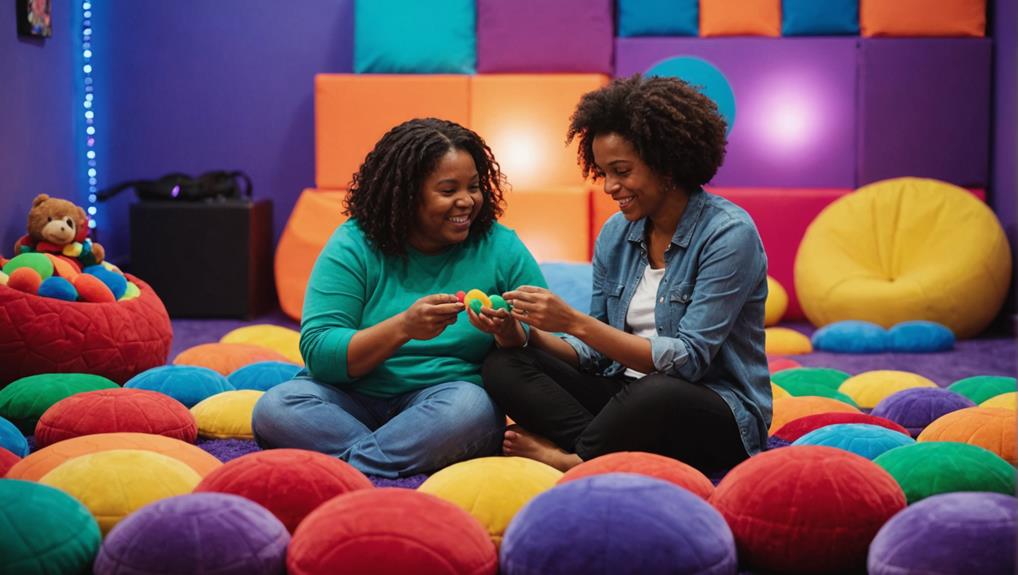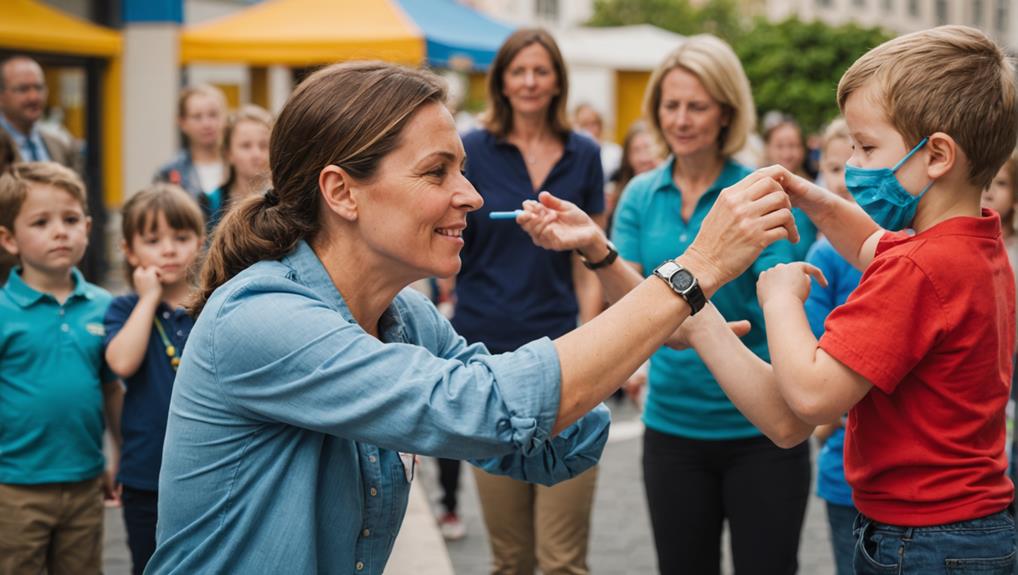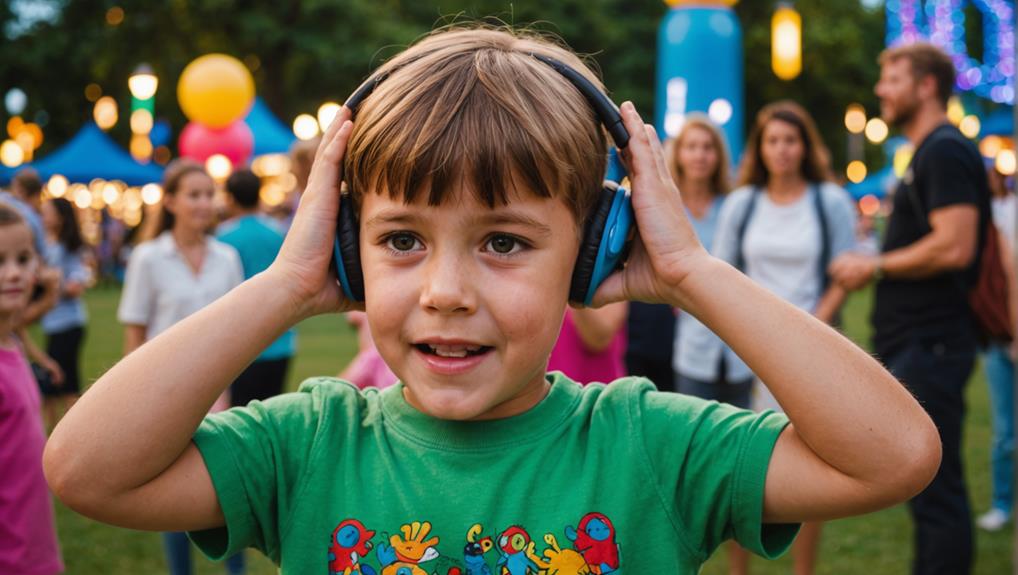As we journey through public spaces, we often underestimate the sensory stimuli that can overwhelm children with sensory processing issues. Occupational therapy offers a wealth of strategies to support these children, enabling more manageable and less distressing experiences in public settings. The approaches are diverse and situation-specific, from developing sensory-friendly environments to utilizing specific self-regulation tools. Let’s delve into how these techniques enable children with sensory overload, their families, and the broader community to nurture an inclusive and empathetic society.
Key Takeaways
- Occupational therapists recommend using visual schedules to help children anticipate and understand upcoming activities in public spaces.
- Creating sensory-friendly kits with noise-canceling headphones or fidget toys can help manage sensory overload during public outings.
- Therapists suggest visiting public places during less crowded periods to minimize sensory stimuli and potential triggers for children.
- Secret signals can help children express their discomfort nonverbally, allowing caregivers to intervene appropriately.
- Advocacy for more inclusive practices in public spaces, such as sensory-friendly hours or events, can help create safer environments for sensory-challenged children.
Understanding Sensory Overload
A significant number of people, especially those with sensory processing issues, autism, ADHD, or anxiety, often struggle with what’s known as sensory overload. This condition occurs when an individual’s sensory system, which can be impacted by disorders such as Sensory Processing Disorder (SPD), is overwhelmed by stimuli in their environment, leading to heightened stress, anxiety, irritability, and difficulty focusing or processing information. Children with SPD may exhibit extreme reactions to touch, sound, or specific movements, indicating an overload of sensory input.
Children are particularly susceptible to sensory overload. Common triggers include loud noises, bright lights, strong smells, crowded spaces, and unfamiliar textures. For children with sensory processing issues, these common environmental factors can become overwhelming, infringing on their ability to navigate public spaces comfortably.
It is essential to understand that sensory overload is not a choice but a response to an avalanche of stimuli. Yet, it can be managed effectively with understanding, patience, and strategies. Occupational therapy is crucial in providing these strategies, equipping children to cope better with sensory overload and enhancing their interaction with the world around them. Understanding sensory overload is the initial step in fostering an environment that supports these children and their distinct needs.
The Role of Occupational Therapy
Occupational therapy stands as a guiding beacon of hope for children struggling with sensory overload. This specialized field focuses on enhancing children’s sensory processing abilities, enabling them to self-regulate feelings, navigate public spaces, and participate in everyday activities effectively.
Occupational therapists are skilled professionals who employ various strategies tailored to each child’s specific sensory needs and challenges. Their primary goal is to foster social participation and improve the overall quality of life for children experiencing sensory overload. This includes using sensory integration therapy to help children with Sensory Processing Disorder (SPD) regulate their responses to sensory stimuli.
The role of pediatric occupational therapy in managing sensory overload includes:
- Enhancing sensory processing abilities to help children interpret and respond to sensory stimuli.
- We are developing self-regulation techniques to manage emotional reactions to sensory overload.
- Improving adaptive skills, enabling children to interact and function in public spaces.
- Personalizing interventions based on each child’s distinct sensory challenges and needs.
- Promoting social participation and enhancing quality of life.
Through their caring and devoted service, occupational therapists significantly impact sensory overload, helping them thrive in all areas of life.
Preparing for Public Outings

How can parents help their children with sensory overload manage public outings? A pivotal initial step is creating a visual schedule. This provides clear expectations and lessens anxiety by establishing predictability. To make it all-encompassing, include activities such as travel time, meal breaks, and return time.
Furthermore, prepare a sensory-friendly kit. This could contain noise-canceling headphones, fidget toys, or other comforting items. Such kits can offer immediate relief from overwhelming sensory inputs. Weighted blankets could also be added to the kit, as they provide a feeling of security and grounding, which can assist children with SPD in handling sensory overload.
Another valuable tactic is secret words or signals. This enables the child to express their discomfort or the requirement for a pause, promoting a feeling of authority over their surroundings.
To decrease sensory overload, consider visiting public spaces during less crowded periods. This can notably reduce the sensory stimuli your child encounters.
Lastly, utilize soothing techniques. These may involve deep pressure embraces or sensory pauses, which can assist body awareness and sensory processing. These techniques can help manage sensory overload during outings, providing instant relief and aiding your child in regaining balance.
Preparing for public outings doesn’t have to be overwhelming. With these strategies, parents can help their children navigate public areas more easily.
Sensory-Friendly Activity Selection
After adequately preparing for public outings, the next step is to carefully select sensory-friendly activities that would not trigger sensory overload in your child. Choosing activities that offer reduced noise levels and dimmer light settings is crucial. This will create a more comfortable environment for a child dealing with sensory overload, allowing them to fully engage without being overwhelmed by sensory stimuli. The concept is akin to the sensory integration techniques used in therapy, which aim to regulate a child’s responses to various sensory input types. This may also involve tailoring the environment to suit the child’s needs better, as therapists do during sessions.
Here are some strategies to help you select the suitable activities:
- Seek out events offering ‘no-applause rules’ to minimize sudden loud noises
- Discover sensory bright events online in your area, tailored explicitly for sensory-challenged children
- Consider attending shows or exhibitions designed to accommodate sensory sensitivities
- Gradually introduce more diverse activities, helping your child acclimate to different sensory inputs
- Look for venues that offer options to reduce noise levels and dim light settings
Parental Involvement in Therapy

The role of parents in the therapy of children experiencing sensory overload, especially those diagnosed with Sensory Processing Disorder, is vital, extending beyond the therapy sessions into the home environment. As symptoms of SPD can manifest as hypersensitivity or hyposensitivity to sensory stimuli, parental understanding and involvement become even more significant. Training provided by therapists equips parents with techniques to maintain a consistent approach toward managing sensory overload, similar to the strategies used in pediatric occupational therapy. This continuity of therapeutic methods, both in professional settings and at home, reinforces the skills learned during therapy sessions and promotes progress, enhancing the overall effectiveness of the treatment.
Training for Home Therapy
Understanding and managing sensory overload in children is a complex task that requires careful guidance and training. Occupational therapists are pivotal in this process, but parental active involvement is equally crucial. Facilitated by parental engagement, home therapy can create a consistent, sensory-friendly environment that supports a child’s distinct sensory needs.
Occupational therapists can train parents to implement sensory activities and techniques reinforcing therapy goals. This hands-on approach allows parents to actively contribute to their child’s progress and monitor their behavior and response changes.
To further elucidate, consider the following aspects of home therapy:
- Parental training by occupational therapists for knowledge enrichment.
- Implementing sensory activities at home to support therapy goals.
- Creating a sensory-friendly environment at home to reduce sensory overload.
- Regular monitoring and assessment of the child’s progress.
- Continuous reinforcement of therapeutic strategies to promote self-regulation.
Strategies for Consistency
Building on the foundation of home treatment, parental participation in occupational therapy for sensory overload emerges as a critical strategy for maintaining consistency in treatment plans. Parents play a crucial role by reinforcing therapy techniques and methods outside therapy sessions, creating a sustainable environment for their child’s progress.
Working closely with occupational therapists, parents can implement sensory-friendly changes at home. These adjustments, guided by the therapist’s expertise, provide a more welcoming environment for the child, reducing sensory triggers and promoting a sense of tranquility. This collaboration helps create a structured sensory diet that caters to the child’s needs, enhancing the effectiveness of the treatment plan.
Consistent parental involvement in therapy promotes better outcomes for children with sensory overload. As part of the therapeutic team, parents provide invaluable insight into the child’s daily experiences, enabling tailored, practical solutions. Thus, parents are not just observers but active participants in their child’s progress toward managing sensory overload. Such an approach ensures that the child receives consistent, supportive, and effective treatment, paving the way for better-coping mechanisms in public settings.
Importance of Sensory Evaluations
The role of sensory evaluations in managing sensory overload cannot be overstated. These assessments are pivotal in pinpointing specific triggers that worsen sensory issues and formulating a thorough approach under the guidance of occupational therapy. Early detection and intervention, facilitated through these evaluations, can significantly improve a child’s comfort, social interaction, and daily functionality.
Identifying Sensory Overload Triggers
Frequently, sensory assessments are essential in pinpointing catalysts for sensory overload in children. These assessments offer valuable insight into a child’s distinct sensory sensitivities and response patterns, enabling parents and therapists to comprehend what may cause discomfort or distress.
This understanding is vital in creating personalized interventions to help manage sensory overload in diverse environments, particularly in public spaces, which often present distinct sensory challenges. Recognizing these triggers enables parents and therapists to aid children in maneuvering through these spaces while also contributing to developing efficient treatment plans.
- Sensory assessments identify specific triggers for sensory overload.
- Understanding sensory sensitivities allows for effective management strategies.
- Personalized interventions can be developed based on the identified triggers.
- Recognizing triggers aids in the creation of thorough treatment plans.
- Identifying triggers empowers parents and therapists to support children in public spaces better.
Identifying sensory overload triggers through sensory assessments is critical in supporting children with sensory sensitivities. This process provides insight into their sensory profile and establishes the groundwork for effective intervention strategies.
Role of Pediatric Occupational Therapy
Sensory evaluations, a part of occupational therapy, are essential in identifying and addressing a child’s unique sensory processing challenges. These assessments examine a child’s responses to sensory stimuli like touch, sound, taste, smell, and movement, providing valuable insight into their sensory landscape.
Understanding a child’s sensory processing difficulties is crucial in creating effective treatment plans. It not only helps in pinpointing the specific areas of concern but also assists in tailoring interventions that are customized and suitable for the child’s particular needs.
Furthermore, sensory evaluations serve as a foundation for tracking progress and measuring the effectiveness of occupational therapy. By capturing a child’s initial sensory processing abilities, therapists can monitor changes and adjust treatment strategies as required, ensuring that the child continues progressing significantly.
Early sensory evaluations can significantly improve the management of sensory overload in public spaces. With a thorough understanding of a child’s sensory profile, parents, teachers, and therapists can collaborate to create supportive and accommodating environments that promote the child’s well-being and development. Occupational therapy, through sensory evaluations, is truly a guiding light for children facing sensory processing challenges.
Benefits of Early Interventions
Building on the importance of occupational therapy in addressing sensory processing challenges, we now focus on the profound impact of early interventions. Recognizing a child with sensory issues early on can significantly enhance their quality of life and help them reach their full potential.
Occupational therapy for sensory issues focuses on understanding each child’s sensory profile. Sensory evaluations are a crucial part of this process. They not only help identify the specific sensory challenges a child may be facing but also provide a baseline to monitor progress and measure the effectiveness of the interventions.
The benefits of early interventions based on these sensory evaluations are numerous:
- They improve outcomes by addressing sensory issues before they become deeply ingrained.
- They enable the development of customized treatment plans to meet each child’s specific needs.
- They help children adapt more effectively to diverse environments, enhancing their ability to learn and interact.
- They reduce the likelihood of other related problems developing, such as behavioral and learning difficulties.
- They equip parents and caregivers with the knowledge and tools to support their children effectively.
Exploring the Eight Senses

Exploring the world of sensory processing involves thoroughly exploring our eight senses – touch, taste, smell, sight, sound, proprioception, vestibular, and interoception. These senses are not just limited to the traditional perception of taste, touch, sight, sound, and smell but also include the less commonly known senses of proprioception (body awareness and movement), vestibular (balance and spatial orientation), and interoception (internal sensations such as hunger and temperature regulation).
Understanding these eight senses is essential in addressing sensory processing challenges. Occupational therapy often targets these senses to help children regulate their responses to sensory input. For instance, proprioception exercises can improve body awareness, while interoception activities can help children better understand their internal sensations.
Recognizing and addressing all eight senses can create more inclusive support systems for children with sensory processing issues. The table below briefly overviews each sense and its role in sensory processing.
| Sense | Description | Role in Sensory Processing |
|---|---|---|
| Touch | Sensation of contact | Assists in navigating the physical world |
| Taste | Sensation of flavor | Shapes food preferences |
| Proprioception | Body awareness | Assists in coordinated movement |
| Interoception | Internal sensations | Regulates physiological needs |
Techniques for Balancing Sensory Input
Addressing the need for balance in sensory input, occupational therapy is essential in aiding children with sensory overload. By employing various techniques, therapists help children manage their sensory responses, especially in public spaces where overwhelming sensory input can be challenging.
Occupational therapy focuses on the following strategies to balance sensory input:
- Deep-pressure activities can help calm the body and mind, reducing the impact of sensory overload.
- Vestibular input: Children can better process sensory stimuli through balance and coordination exercises.
- Tactile experiences: Children can familiarize themselves with diverse sensations through different textures and materials, aiding in sensory processing.
- Sensory integration therapy exposes children to controlled sensory stimuli, promoting improved sensory processing.
- Environmental modifications: Adjusting the environment in public spaces can create a sensory-friendly setting, easing the effects of sensory overload.
Each of these interventions is customized to help children navigate the intricacies of sensory overload in public settings. With the guidance of occupational therapists, children can learn to balance sensory input effectively, leading to greater comfort and success in their daily lives.
Recognizing Sensory Sensitivities

While sensory sensitivities can manifest in various ways, they often appear as hypersensitivity or hyposensitivity to stimuli such as touch, sound, taste, smell, and movement. Recognizing these sensitivities in children, especially in public spaces, is crucial in providing supportive and inclusive environments that cater to their distinct sensory processing challenges.
Children with heightened sensitivities may display signs of stress, anxiety, or behavioral issues when exposed to overwhelming stimuli. For example, a child hypersensitive to sound may cover their ears in noisy environments. Conversely, a child with hyposensitivity may seek intense sensory experiences, such as spinning or touching everything.
Below is a table illustrating some common signs of sensory sensitivities:
| Hypersensitivity | Hyposensitivity |
|---|---|
| Avoids or is distressed by touch | The constant need to touch things |
| Covers ears in noisy environments | Appears not to notice loud noises |
| Dislikes specific tastes or smells | Seeks out intense flavors or smells |
| Uncomfortable with movements | Seeks out intense movement experiences |
Understanding and recognizing these signs is vital to mitigating sensory overload and fostering an environment where all children can thrive. Empathy and awareness can make public spaces more accommodating for children with sensory sensitivities.
Tips for Managing Sensory Issues
Supporting children with sensory issues involves a multi-faceted approach, including therapy and practical strategies. Occupational therapy offers a wealth of techniques to help children manage sensory overload in public spaces.
From a therapeutic standpoint, deep pressure and vestibular input can be instrumental in calming sensory issues. Similarly, adjustments in the surroundings can help make public spaces less overwhelming for these children.
Sensory-friendly tools also play an essential role in managing sensory overload. Items such as noise-canceling headphones and weighted blankets can help deflect overwhelming stimuli, provide a sense of security, and calm children in different public settings.
Establishing predictable routines and schedules is another effective strategy. This method helps children with sensory overload navigate public spaces more comfortably by offering a sense of predictability and control.
Occupational therapists can work closely with families to develop personalized plans for children with sensory challenges. This collaborative approach guarantees that children receive the support they need to navigate public spaces comfortably.
Benefits of Sensory Toys and Play

Sensory toys offer many benefits beyond entertainment that aid in the holistic development of children facing sensory overload. These tools can enrich learning and cognitive development through play, fostering social engagement and sparking creativity. Alongside the guidance of supportive therapy, these sensory stimulation tools can be instrumental in meeting developmental milestones, making them a crucial asset in managing sensory processing difficulties.
Sensory Toy Advantages
Sensory toys can significantly shape language and social skills in child development. They are not just playthings but tools that stimulate the senses, foster exploration, and support occupational therapy.
The benefits of sensory toys are manifold:
- They help build language and vocabulary by enriching children’s understanding of words and promoting social interaction. This is vital for their overall language development.
- Sensory toys stimulate multiple senses simultaneously, encouraging exploration. This aids in nurturing creativity and cognitive development in children.
- Playing with sensory toys improves sensory processing skills. This enables children to interact with their surroundings with less fear and more natural play.
- Describing activities with sensory toys enhances communication skills, builds vocabulary, and encourages verbal expression in children. This is necessary for their cognitive development.
- Sensory toys can combat sensory processing difficulties in occupational therapy. They offer personalized sessions and guidance to help children achieve their developmental goals.
Supporting children with sensory overload requires empathy and understanding. Sensory toys offer a practical and enjoyable way to facilitate their growth and development.
Enhancing Learning Through Play
Building on sensory toys’ advantages, we now investigate how they can enrich learning through play. Sensory toys provide multiple benefits for children, especially those with sensory sensitivities. They stimulate several senses simultaneously, promoting language and vocabulary development.
Sensory play, facilitated by these toys, fosters social interaction, urging children to investigate and express their creativity. This type of play is more than mere fun; it’s a crucial tool in enhancing cognitive development. It strengthens sensory processing skills essential for everyday tasks like dressing, eating, and playing.
Furthermore, sensory play supports language development. As children engage with sensory toys, they learn to describe their experiences, feelings, and objects, expanding their vocabulary and communication skills.
Occupational therapy integrates sensory toys and games into its interventions, enhancing learning, communication, and comprehensive development. Through a carefully designed sensory play environment, children are encouraged to learn, grow, and overcome their sensory sensitivities.
Role of Supportive Pediatric Therapy
While sensory toys and play provide significant benefits, supportive therapy’s vital role in a child’s development must be acknowledged. Pediatric occupational therapy, in particular, focuses on addressing sensory processing difficulties. By utilizing sensory toys in therapy sessions, children are encouraged to investigate and interact, nurturing their communication skills and creativity.
Occupational therapists provide personalized lessons, ensuring each child receives the guidance required to achieve their developmental goals. The integration of sensory play into therapy not only boosts cognitive development but also enhances sensory processing skills.
The key benefits of incorporating sensory toys and play into supportive therapy include:
- We are promoting enriched language and vocabulary through multi-sensory stimulation.
- We are encouraging social interaction, which is vital for developing emotional intelligence.
- They are nurturing exploration and creativity, leading to cognitive development.
- We are enhancing sensory processing abilities, which are essential for daily functioning.
- PWe are providing tailored guidance to support children in achieving developmental milestones.
Frequently Asked Questions
What Does an Occupational Therapist Do for a Child With Sensory Issues?
Occupational therapists aid children with sensory issues through sensory integration therapy, enhancing their ability to process sensory input. They assist in developing self-regulation skills and adaptability, ultimately improving daily functioning and social interactions.
How Can We Help Sensory Overload in Public?
Occupational therapists recommend using deep pressure techniques, vestibular input, environmental modifications, and sensory-friendly environments to assist children with sensory overload in public. Consistent therapy and early intervention can also improve their coping skills.
What Are Sensory-Based Interventions for Occupational Therapists?
Sensory-based interventions by occupational therapists involve tailored activities that stimulate specific sensory systems. They aim to address sensory processing issues, support integration, promote self-regulation, and improve participation in daily tasks for children experiencing sensory overload.
How to Help a Child With Sensory Overload?
To assist a child experiencing sensory overload, create a safe, quiet retreat, use noise-canceling devices or sunglasses, provide sensory tools such as fidget toys, practice calming techniques, and communicate about their sensory needs.
Conclusion
To sum up, occupational therapy contributes unmatched to supporting children with sensory overload in public areas. Introducing sensory-friendly surroundings, visual schedules, and sensory breaks, along with caregiver education and promotion of inclusivity, enables these children to navigate public settings with relative ease. A thorough comprehension of sensory requirements, provision of self-regulation aids, and establishment of supportive environments pave the way for a future where no child is excluded because of sensory difficulties.


Recent Comments